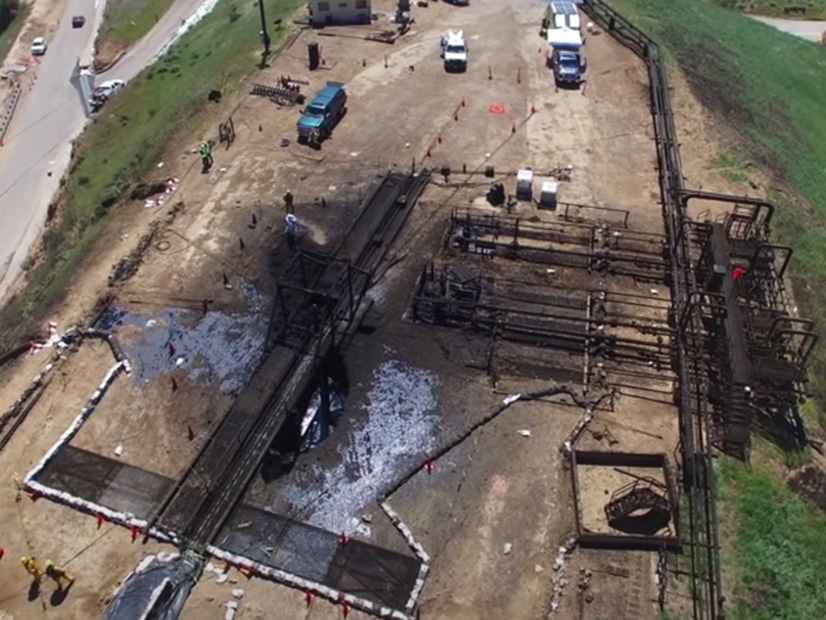
Southern California Gas proposed plans Thursday for what could be the largest green hydrogen infrastructure in the nation, with pipelines moving hydrogen from solar farms in the Mojave Desert and other inland areas to customers in the Los Angeles Basin.
The preliminary plan submitted to the California Public Utilities Commission proposes “one or more trunk transmission pipelines that would run from green hydrogen generation sources,” where renewable resources would be used to manufacture hydrogen, an energy-intensive process.
“The project would benefit ratepayers and the state by advancing California’s net zero goals, increasing use of clean fuels” and help to “facilitate the ultimate closure of [SoCalGas’] Aliso Canyon underground gas storage facility,” site of a massive natural gas leak in 2015, the utility’s application to the CPUC said.
SoCalGas asked the commission only for a memorandum account to keep track of expenses, for possible cost recovery later, as it pursues early-stage research and development. It requested that the CPUC approve the account by July. But it said the proposal was significant enough, “given the innovation and broad environmental benefits … [that] SoCalGas believes it important to provide the commission and the public with information about the project and its context in this first filing.”
“In one or more subsequent filings, SoCalGas expects to seek commission approval of the project and recovery of just and reasonable costs incurred,” it said.
SoCalGas is the largest gas utility in the U.S., with 5.8 million customer accounts and more than $3.6 billion in sales in 2020, according to the American Gas Association.
Hydrogen Hub
The application added to the focus on Los Angeles as a center of green hydrogen development.
The Los Angeles Department of Water and Power (LADWP) is converting its coal-fired Intermountain Power Plant in Utah to an 840-MW combined cycle natural gas-fired facility. The plant will be capable of burning a fuel mixture consisting of 30% hydrogen when it opens in 2025, transitioning to 100% by 2045, the utility has said.
A report published last March by the National Renewable Energy Laboratory — titled “LA100: The Los Angeles 100% Renewable Energy Study” — showed that LADWP will require a large amount of dispatchable generation closer to home to reach a 100% clean-energy goal and replace four outmoded natural gas plants that need to be rebuilt or retired.
The Los Angeles City Council voted in September to require that 100% of the electricity used in the city be carbon-free by 2035, establishing a 2030 deadline for replacing the gas-fired plants.
And the Green Hydrogen Coalition has been leading development of a green hydrogen hub in Southern California. The goal of the HyDeal Los Angeles initiative is to deliver green hydrogen for the Los Angeles Basin at $1.50/kg by 2030.
In a probable boost to that effort, the $1.2 trillion infrastructure bill passed by Congress in November provides $8 billion for development of four green hydrogen hubs in the U.S. and $1 billion toward domestic production of the electrolyzers needed to produce hydrogen, part of the Department of Energy’s Hydrogen Energy Earthshot initiative. (See ‘Ecosystems’ Needed to Drive Green Hydrogen Growth.)
SoCalGas said its new plan, called “Angeles Link,” could provide the green hydrogen needed to convert the four outdated gas plants to cleaner generation and displace up to 3 million gallons of diesel fuel per day, if heavy-duty diesel trucks are replaced by hydrogen fuel-cell trucks.
“As contemplated, the Angeles Link would deliver green hydrogen in an amount equivalent to almost 25 percent of the natural gas SoCalGas delivers today,” the utility said in a news release.
LADWP praised the effort.
“We are encouraged that SoCalGas is embarking on a major project that will help make green hydrogen a reality here in Los Angeles,” LADWP General Manager Marty Adams said in the SoCalGas statement. “Developing a source of safe, affordable green hydrogen is key to achieving our clean energy future by 2035, while ensuring the reliability we all need and depend on.”
Spotty Record
California is legally mandated to replace all fossil-fuel generation serving retail customers with clean-energy resources by 2045 and to reduce greenhouse gas emissions 40% below 1990 levels by 2030. How a partial replacement of natural gas with green hydrogen might play out under the mandates is untested and could prove problematic.
SoCalGas said in its application that green hydrogen could help decarbonize “‘hard-to-electrify industries,’ electric generation and the heavy-duty transportation sector” while advancing “progress toward net zero goals.”
The CPUC has yet to take any action regarding SoCalGas’ application.
The utility has wrangled with its regulator in recent years, being punished for misdeeds — including a nearly $10 million fine earlier this month — that the pipeline announcement appears geared to partly offset in the public eye.
SoCalGas’ past run-ins with the CPUC include the long-running Aliso Canyon controversy, which resulted in a CPUC investigation and continued oversight. It also generated last year’s $1.8 billion legal settlement between plaintiffs, SoCal Gas and parent company Sempra Energy.
In April 2019, the CPUC fined SoCalGas $8 million for failing to send out prorated customer bills in a timely manner, resulting in higher bills and extending the billing period for many customers.
On Feb. 3, the CPUC fined SoCalGas $9.8 million for misspending ratepayer funds for advocacy work on building codes. The commission had prohibited such activities in 2018 after its Public Advocates Office determined SoCalGas inappropriately used ratepayer money to fight energy-efficient building standards.
In its proposed decision, the CPUC said SoCalGas had shown “profound, brazen disrespect for the commission’s authority” during the investigation and deserved to be penalized.
The company said in a brief statement it was reviewing the decision and looked forward to “further engagement.” It has 30 days from the issuance date to challenge the ruling, after which the proposed decision becomes final.

